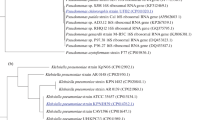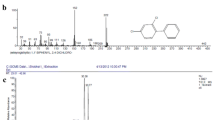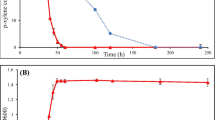Abstract
Twenty three bacterial isolates either pure or consortium were initially screened on the basis of their ability to degrade as well as dechlorinate 4 — chlorobenzoic acid (4-CBA). Based on comparative growth response, three pure isolates Pseudomonas putida GVS-4, Pseudomonas aeruginosa GVS-18 and Pseudomonas aeruginosa GWS-19 and a consortium SW-2 was finally selected for further studies. The enzyme studies performed with cell free extracts revealed that dehalogenase activity was substrate specific with maximum activity at 300 μgml−1 substrate concentration. Catechol 1,2 dioxygenase activity was found to be present in cell free extracts suggesting that 4 — chlorobenzoic acid (4-CBA) is catabolized by ortho-ring cleavage pathway. The dehalogenase enzyme profile showed single enzyme band in case of GVS-4 (Rm 0.76), GVS-18 (Rm 0.84), GWS −19 (Rm 0.85) and two bands in SW-2 (Rm 0.71 & 0.10).
Similar content being viewed by others
References
Kalra RL, Chawla RP, Sharma ML, Battu RS & Gupta SC (1983) Residues of DDT and HCH in butter and ghee in India, 1979–81. Environ Pollu 6:195–206
Kalra RL & Chawla RP (1983) Studies on pesticide residues and monitoring of pesticidal pollution. Technical report p-480, Department of Entomology, Punjab Agricultural University, Ludhiana
Deo PG, Karanth NG & Karanth NGK (1994) Microbial degradation of pesticides. Ind J Microbiol 34:241–263
Raizada N (1996) Organochlorine pesticide residues in environmental components, food materials and human tissues. In: International Seminar “Problem of monitoring of pesticide residues in exportable commodities viz. rice, tea, fish and minor crops,” Colombo, Sri Lanka
Timmis KN, Steffan RJ & Unterman R (1994) Designing microorganisms for the treatment of toxic wastes. Ann Rev Microbiol 48:525–527
Garbisu C & Alkorta I (1997) Bioremediation. Principles and Future. J Clean Technol Environ Toxicol and Occup Med 6:1–6
Spain RJ (1995) Biodegradation of nitroaromatic compounds. Annu Rev Microbiol 49:523–555
Liu S & Suflita JM (1998) Ecology and evolution of microbial populations for bioremediation. Trends in Biotech 11:344–352
Garbisu C & Alkorta I (1999) Utilization of genetically engineered microorganisms (GEMs) for bioremediation. J Chem Technol Biotechnol 74:599–606
Fetzner S & Lingens F (1994) Bacterial Dehalogenases: Biochemistry, Genetics and Biotechnological Applications. Microbiol Rev 58:641–685
Singh H & Kahlon RS (1989) Biochemical and Genetic studies on degradation of chlorobenzoates by Pseudomonas. Acta Microbiologica Polonica 38:259–269
Mohn WW & Tiedje JM (1992) Microbial reductive dehalogenation. Microbiol Rev 56:482–507
Jensen HL (1960) Decomposition of chloroacetates and chloropropionates by bacteria. Acta Agriculture Scandinavica 10:83–103
Slater JH, Lovatt D, Weightman AJ, Senior E & Bull AT (1979) The growth of Pseudomonas putida on chlorinated aliphatic acids and its dehalogenase activity. J Gen Microbiol 114:125–136
Dorn E, Hellwig M, Reineke W & Kanckmuss HJ (1974) Isolation and characterization of a 3-chlorobenzoate degrading Pseudomonas Arch Microbiol 99:61–70
Bergmann JG & Sainik J (1957) Determination of trace amounts of chlorine in naptha. Analyt Chem 29:241–243
Dorn E & Knackmuss HJ (1978) Chemical structure and biodegradability of halogenated aromatic compounds. Two catechol 1, 2 dioxygenases from a 3-chlorobenzoate grown pseudomonad. Biochem J 174:73–84
Nozaki M (1970) Metapyrocatechase (Pseudomonas). Methods Enzymo 17a:522–525
Lowry OH, Rosebrough NJ, Farr AC & Randall RJ (1951) Protein measurement with Folin-phenol reagent. J Biol Chem 193:265–273
Davis BJ (1964) Disc-gel electrophoresis II: Method and Applications to Human Serum Proteins. Ann NY Acad Sci 121:404–427
Tros ME, Scheaa G & Zhender AJB (1996) Transformation of low concentration of 3-chlorobenzoate by Pseudomonas sp. strain B13: kinetics and residual concentrations. Appl Environ Microbiol 62:437–442
Sandhu N (2002) Biochemical and genetic studies on dechlorinases of Pseudomonas sp. Ph.D. Dissertation, PAU, Ludhiana, India
Kocher GS and Kahlon RS (1999) Dehalogenation of 2-chlorobenzoic acid by Pseudomonas pickettii. Ind J Microbiol 39:245–247
Hardman DJ & Slater JH (1981) Dehalogenases in soil bacteria. J Gen Microbiol 123:117–128
Koch AL (1972) Enzyme evolution. In: The Importance of Untranslatable Intermediates. Genetics 72:297–316
Zaitsev GM & Karasevich Yu N (1984) Utilization of 2-chlorobenzoic acid by Pseudomonas cepacia. Mikrobiologiya 53:75–80
Fetzner S, Muller R & Lingens F (1989) A novel metabolite in the microbial degradation of 2-chlorobenzoate. Biochem Biophys Res Commun 161:700–705
Sylvestre M, Mailhot K & Ahmad D (1989) Isolation and Preliminary characterization of a 2-chlorobenzoate degrading Pseudomonas. Can J Microbiol 35:439–443
Kahlon RS & Singh G (1994) Pseudomonas: Genetics and emerging biotechnology. In: Kahlon R S (eds). Perspectives in Microbiology. pp 21–29. NATIC Press, Ludhiana
Author information
Authors and Affiliations
Corresponding author
Rights and permissions
About this article
Cite this article
Banta, G., Kahlon, R.S. Dehalogenation of 4 — Chlorobenzoic Acid by Pseudomonas isolates. Indian J Microbiol 47, 139–143 (2007). https://doi.org/10.1007/s12088-007-0027-5
Received:
Revised:
Accepted:
Published:
Issue Date:
DOI: https://doi.org/10.1007/s12088-007-0027-5




